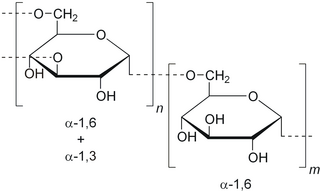
A carbohydrate is a biomolecule consisting of carbon (C), hydrogen (H) and oxygen (O) atoms, usually with a hydrogen–oxygen atom ratio of 2:1 and thus with the empirical formula Cm(H2O)n, which does not mean the H has covalent bonds with O. However, not all carbohydrates conform to this precise stoichiometric definition, nor are all chemicals that do conform to this definition automatically classified as carbohydrates.

A disaccharide is the sugar formed when two monosaccharides are joined by glycosidic linkage. Like monosaccharides, disaccharides are simple sugars soluble in water. Three common examples are sucrose, lactose, and maltose.

Glucose is a sugar with the molecular formula C6H12O6. Glucose is overall the most abundant monosaccharide, a subcategory of carbohydrates. Glucose is mainly made by plants and most algae during photosynthesis from water and carbon dioxide, using energy from sunlight, where it is used to make cellulose in cell walls, the most abundant carbohydrate in the world.

Polysaccharides, or polycarbohydrates, are the most abundant carbohydrates found in food. They are long-chain polymeric carbohydrates composed of monosaccharide units bound together by glycosidic linkages. This carbohydrate can react with water (hydrolysis) using amylase enzymes as catalyst, which produces constituent sugars. They range in structure from linear to highly branched. Examples include storage polysaccharides such as starch, glycogen and galactogen and structural polysaccharides such as cellulose and chitin.

Sugar is the generic name for sweet-tasting, soluble carbohydrates, many of which are used in food. Simple sugars, also called monosaccharides, include glucose, fructose, and galactose. Compound sugars, also called disaccharides or double sugars, are molecules made of two bonded monosaccharides; common examples are sucrose, lactose, and maltose. White sugar is a refined form of sucrose. In the body, compound sugars are hydrolysed into simple sugars.

Mannans are polymers containing the sugar mannose as a principal component. They are a type of polysaccharide found in hemicellulose, a major source of biomass found in higher plants such as softwoods. These polymers also typically contain two other sugars, galactose and glucose. They are often branched.

Xanthan gum is a polysaccharide with many industrial uses, including as a common food additive. It is an effective thickening agent, emulsifier, and stabilizer that prevents ingredients from separating. It can be produced from simple sugars using a fermentation process and derives its name from the species of bacteria used, Xanthomonas campestris.

Dextran is a complex branched glucan, originally derived from wine. IUPAC defines dextrans as "Branched poly-α-d-glucosides of microbial origin having glycosidic bonds predominantly C-1 → C-6". Dextran chains are of varying lengths.

Gentiobiose is a disaccharide composed of two units of D-glucose joined with a β(1->6) linkage. It is a white crystalline solid that is soluble in water or hot methanol. Gentiobiose is incorporated into the chemical structure of crocin, the chemical compound that gives saffron its color. It is a product of the caramelization of glucose. During a starch hydrolysis process for glucose syrup, gentiobiose, which has bitterness, is formed as an undesirable product through the acid-catalyzed condensation reaction of two D-glucose molecules. One β-D-glucose unit elongation of the bitter disaccharide reduces its bitterness by a fifth, as determined by human volunteers using the trimer, gentiotriose. Gentiobiose is also produced via enzymatic hydrolysis of glucans, including pustulan and β-1,3-1,6-glucan.

Akira Endo is a Japanese biochemist whose research into the relationship between fungi and cholesterol biosynthesis led to the development of statin drugs, which are some of the best-selling pharmaceuticals in history.
Leuconostoc mesenteroides is a species of lactic acid bacteria associated with fermentation, under conditions of salinity and low temperatures. In some cases of vegetable and food storage, it was associated with pathogenicity. L. mesenteroides is approximately 0.5-0.7 µm in diameter and has a length of 0.7-1.2 µm, producing small grayish colonies that are typically less than 1.0 mm in diameter. It is facultatively anaerobic, Gram-positive, non-motile, non-sporogenous, and spherical. It often forms lenticular coccoid cells in pairs and chains, however, it can occasionally form short rods with rounded ends in long chains, as its shape can differ depending on what media the species is grown on. L. mesenteroides grows best at 30°C, but can survive in temperatures ranging from 10°C to 30°C. Its optimum pH is 5.5, but can still show growth in pH of 4.5-7.0.

Sucrose phosphorylase is an important enzyme in the metabolism of sucrose and regulation of other metabolic intermediates. Sucrose phosphorylase is in the class of hexosyltransferases. More specifically it has been placed in the retaining glycoside hydrolases family although it catalyzes a transglycosidation rather than hydrolysis. Sucrose phosphorylase catalyzes the conversion of sucrose to D-fructose and α-D-glucose-1-phosphate. It has been shown in multiple experiments that the enzyme catalyzes this conversion by a double displacement mechanism.

Diferulic acids (also known as dehydrodiferulic acids) are organic compounds that have the general chemical formula C20H18O8, they are formed by dimerisation of ferulic acid. Curcumin and curcuminoids, though having a structure resembling diferulic acids', are not formed that way but through a condensation process. Just as ferulic acid is not the proper IUPAC name, the diferulic acids also tend to have trivial names that are more commonly used than the correct IUPAC name. Diferulic acids are found in plant cell walls, particularly those of grasses.

Isomaltose is a disaccharide similar to maltose, but with a α-(1-6)-linkage instead of the α-(1-4)-linkage. Both of the sugars are dimers of glucose, which is a pyranose sugar. Isomaltose is a reducing sugar. Isomaltose is produced when high maltose syrup is treated with the enzyme transglucosidase (TG) and is one of the major components in the mixture isomaltooligosaccharide.
Laminaribiose C12H22O11 is a disaccharide which is used notably in the agricultural field and as an antiseptic. It is in general obtained by hydrolysis or by acetolysis of natural polysaccharides of plant origin. It is also a product of the caramelization of glucose.

Kojibiose is a disaccharide. It is a product of the caramelization of glucose. It is also present in honey.
Sophorose is a disaccharide, a dimer of glucose. It differs from other glucose dimers such as maltose in having an unusual β-1,2 bond. It was isolated in 1938 from pods of Sophora japonica. It is a component of sophorolipids. It is a product of the caramelization of glucose.
Glucan 1,6-α-isomaltosidase is an enzyme with systematic name 6-α-D-glucan isomaltohydrolase. It catalyses hydrolysis of (1→6)-β-D-glucosidic linkages in polysaccharides, to remove successive isomaltose units from the non-reducing ends of the chains
Branched-dextran exo-1,2-α-glucosidase is an enzyme with systematic name (1→2)-α-D-glucosyl-branched-dextran 2-glucohydrolase. It catalyses the hydrolysis of (1→2)-α-D-glucosidic linkages at the branch points of dextrans and related polysaccharides, producing free D-glucose.

Isolichenan, also known as isolichenin, is a cold-water-soluble α-glucan occurring in certain species of lichens. This lichen product was first isolated as a component of an extract of Iceland moss in 1813, along with lichenin. After further analysis and characterization of the individual components of the extract, isolichenan was named in 1881. It is the first α-glucan to be described from lichens. The presence of isolichenan in the cell walls is a defining characteristic in several genera of the lichen family Parmeliaceae. Although most prevalent in that family, it has also been isolated from members of the families Ramalinaceae, Stereocaulaceae, Roccellaceae, and Cladoniaceae. Experimental studies have shown that isolichenan is produced only when the two lichen components – fungus and alga – are growing together, not when grown separately. The biological function of isolichenan in the lichen thallus is unknown.















